Unsolved Mystery: Dinner on Diablo's Shore
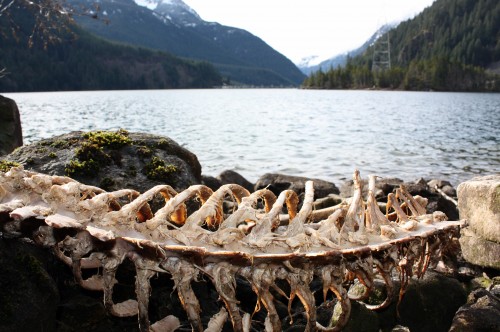
Several weeks back, North Cascades Environmental Learning Center was abuzz with talk of an animal kill on campus near the Peninsula Trail behind the dining hall.
A chunk of fur found on the peninsula by Remote Medical International instructor and former North Cascades Institute staff member, Adam Russell, was the first clue to the kill. Adam had found the hair while observing a rescue scenario conducted by Wilderness EMT students who were staying at the Learning Center at the time. What was unique about the hair Adam found was how it was clipped from the missing carcass in clean cuts, as if it had been cut by scissors. Naturalist sleuths made hypotheses that it was a feline kill, as cats use their incisors to clip their prey’s fur in chunks.
Adam and several others did a brief sweep of the peninsula to look for further signs of the kill, but none were found. Several days later, Institute staff member, Katie Roloson, and some friends were out for a canoe on Diablo Lake when they noticed a deer skeleton splayed on the rocky shore of the peninsula. The clues were starting to fit together, but the mystery remained. Many thought the carcass was less than a week old based on its condition, but no one knows for sure.
With the excitement of the new discovery, I decided to examine the evidence for myself.
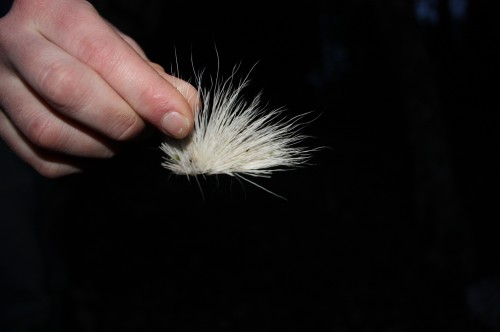
Clippings of fur were the initial sign of an animal kill near the Peninsula Trail.
This is the position I found the deer skeleton upon my initial visit.
As the sun set over the snowy peaks across the lake and darkness set in, several fellow graduate students and I headed down the short leg of the Peninsula Trail. We cut over to the shore of Diablo Lake to find the deer skeleton splayed over a large rock. The skeleton was picked clean, except for some meat that remained on the attached hind legs. It has been discussed that ravens most likely picked the skeleton clean in addition to other animals. What was interesting was that the front legs, hooves and mandible were missing, no one was able to find any of them at the time. Nearby, a pile of deer hair lay scattered on rocks and soil, many which appeared clipped like the initial fur found elsewhere on the peninsula. Crushed bone and hoof were also found near the hair pile.
I had never before seen such a clear display of this portion of the lifecycle, and decided to observe the skeleton over the next month for any changes.
Deer remains of fur, bone and hoof were found several feet away from the skeleton.
The skeleton had changed position several days after my initial visit.
The missing mandible was eventually discovered several feet away from the skeleton.
A piece of the spinal column was discovered next to the mandible.
Each time I have returned to the site I’ve found the skeleton to be repositioned.
Upon my second visit, the skeleton was moved away from the rock and appeared curled up on the rocky shore. I wondered if the animal who killed the deer had returned or if new animals had been scoping out the potential food source. I noticed the muscle on the back legs remained. I assumed it wouldn’t be too long before it was consumed.
I poked around the shore a bit looking for more clues, and found the mandible located several feet away from the skeleton between some large rocks. I also found a piece of the spinal column, but still no sign of the forelegs.
I took a closer look at the teeth structure of the mandible and skull. The teeth appeared old and worn, resembling what I would assume to be an older adult. It was a great opportunity to see the dental structure of this herbivore, but since the nose of the skull had been chewed off I couldn’t see the horny pad, the toothless portion at the top of a deer’s mouth used to grind and tear vegetation.
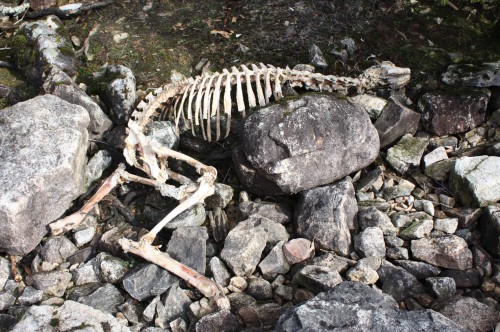
The skeleton found in another position upon another visit.
The discoloring and wear and tear of the teeth led me to assume the carcass was that of an older deer. The nose that’s missing from the skull was most likely chewed off by prey.
I have returned to the sight multiple times since my second visit. Each time the skeleton was repositioned. When I visited this past weekend the snow had melted away from most of the shore and revealed a skeleton that had been flipped to the other side since I last saw it. I noticed several ribs were now missing.
What surprised me most was the meat on the hind legs remains today, and I’ve wondered why animals haven’t chosen to touch that portion of the deer.
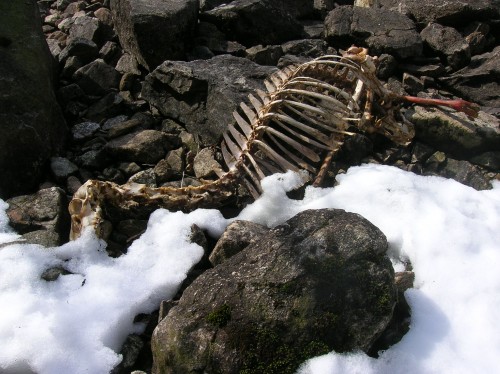
Deer skeleton shown on the other side of large rock in another position following the melt of last week’s snowfall.
Missing ribs on the skeleton were a new observation I made during my visit latest visit.
Animals so far have refrained from eating the meat on the hind legs.
Aside from not seeing a large, intact skeleton like this before, I had also not had the opportunity to make these observations over time with an animal’s remains. These observations have been a great experience as we prepare to teach Mountain School students at the Learning Center about carnivores of the North Cascades, their habitat and predator/prey relationships. Many of us at the Learning Center have guessed how the deer died and who has been consuming its remains. Perhaps the deer died of natural causes or old age and was dragged to the location near the Peninsula Trail. Maybe the deer was killed by a predator.
Was it feline? Canine? The most common guess has been cougar, but so far we have been unable to positively confirm that hypothesis.
What do you think? Let us know of your thoughts or share observations you’ve had similar to this experience.
Photos courtesy of Kate Rinder and Codi Hamblin.

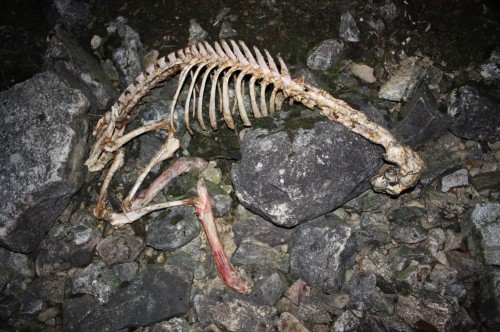
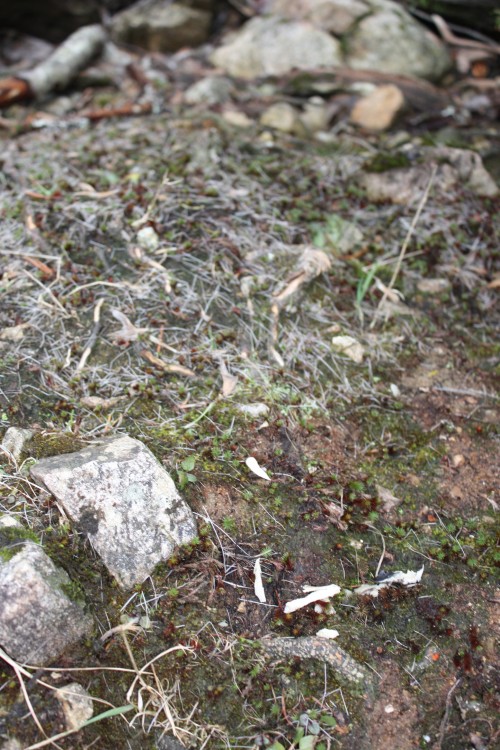
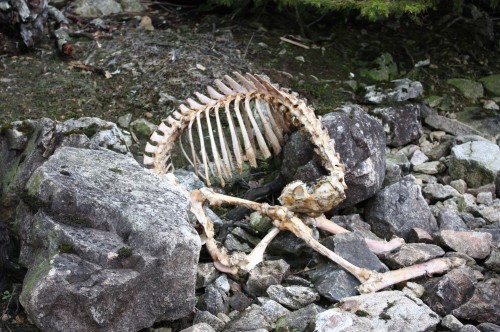

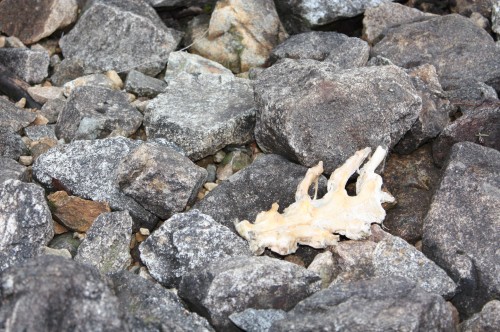
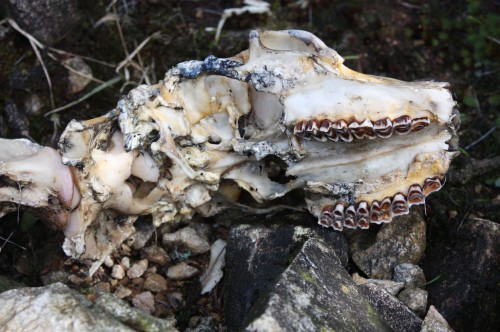

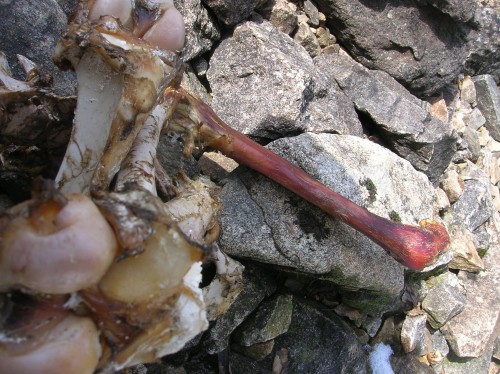
Interesting article Codi. Was the carcass hidden at all? From everything that I’ve read, cougars tend to hide their kills and won’t typically leave them in the open. Also, the fact that it’s nose was broken off may also be an indicator of a cougar, since they will typically try to suffocate their prey by grabbing the nose or even the neck to cut off the flow of oxygen. Did you look for any other signs like scat or tracks?
Really interesting! Again, the pictures are great and really make the story come to life for me….even though you told me about this I couldn’t quite envision it from your perspective. I can imagine this was a great education in itself, and a good case study for teaching. Everyone loves a puzzle!
Very interesting scenario. Looking like something large killed it and the coyotes drug it to its current local. Not nearly enough hair at the scene to be the original kill site. (and FYI your piece of “Spinal Column” is actually the Sternum).
Although the “Meat” on the back legs looks like something that was Skinned by a human and let air dry.
And I know its been more than a year, but have you been back to the site to see how the bones changed over the summer and winter?
I happen to be visiting in hidden valley CA and had been to the lake today going on my normal hike when I found e deer positioned just like this one. neck and I believe hip bone. at first I thought I had the skull then after recalling previous skulls the eye sockets were misplaced for that of a deer. found this sight in trying to id the bone I have. it is possible I have a fully intact pelvis. the spine intact and left looked like it was held together by jerky strands and the lower legs left with fur and jerkyish material. however other extremely smaller mandible and ribs were found